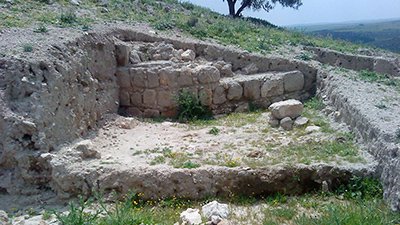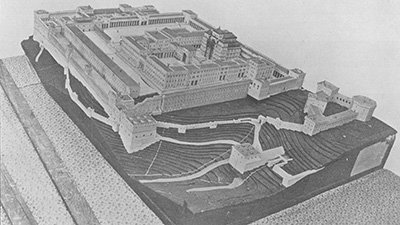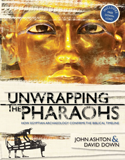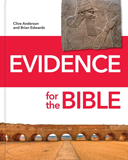
Biblical Landmark of King Solomon’s Time Found
Once again, a bit of biblical history has been matched up with an archaeological finding.
News Source
- UC San Diego: “King Solomon’s (Copper) Mines?”
A team led by archaeologists from the United States and Jordan has made a discovery of perhaps biblical proportions at the Ruins of Copper (Arabic “Khirbat en-Nahas”), a region south of the Dead Sea now lying in Jordan.
The site has been known for decades to have hosted metalworking dating back some seven centuries BC. But the current team, led by Thomas Levy of the University of California–San Diego and Mohammad Najjar of Jordan’s Friends of Archaeology, unearthed materials such as seeds and sticks that are claimed to be from the 10th century BC. That was the time of King Solomon, whom the Bible notes was “greater in riches . . . than all the other kings of the earth” (1 Kings 10:23) and who had unprecedented access to natural resources, presumably including copper, but also many others from sources near and far.
As for Levy, he cautions that “We can’t believe everything ancient writings tell us” even while acknowledging that his research “represents a confluence between the archaeological and scientific data and the Bible.”1
We might ask Levy just why it is that we can’t believe what the Bible (which we presume is the main target of “ancient writings”) tells us, even when his own research reminds us of the accuracy of this specific part of it. Our expectation is that Levy’s answer would center on either his presupposed religious beliefs or his acceptance of evolution in explaining the origin of life and the history of humanity. But when we start from the Bible, we find it makes perfect sense of the science we conduct and the observations we make.
In related news, BBC News reports on what could be the oldest Hebrew text found to date: five lines on a shard of pottery found at a dig 20 km southwest of Jerusalem.2 Researchers are still working to translate the full text, which is written in proto-Canaanite, a precursor of the Hebrew alphabet. A few of the words have been translated already, including “judge,” “slave,” and “king.” But for now, they can’t be entirely sure it was the language of the ancient Hebrews, as opposed to a related language spoken in the same area.
“The findings could shed significant light on the period of King David’s reign.”
What’s behind most of the headlines, however, is the dating of the pottery at just around 3,000 years ago—the time of King David (and just before King Solomon). Because the pottery and other artifacts where found near the Valley of Elah, where the Bible says David fought Goliath, lead archaeologist Yosef Garfinkel believes “the findings could shed significant light on the period of King David’s reign,” reports the BBC.
The Associated Press reports that the “discoveries are already being wielded in a vigorous and ongoing argument over whether the Bible’s account of events and geography is meant to be taken literally.”3 We certainly can’t imagine what person familiar with, in this case, 2 Samuel would suggest it’s meant to be taken as anything other than literal history!
The report also adds a comment by archaeologist Israel Finkelstein, who cautioned against “the belief that what’s written in the Bible is accurate like a newspaper.” Thankfully, we know that the Bible is much more accurate than newspapers are! And while an artifact from the time of David would be a wonderful discovery, we do not use “evidence” to prove or disprove Scripture; that would be setting up something (in this case, archaeology—and carbon dating) as an authority over Scripture.
Further Reading
- Does Archaeology Support the Bible?
- Doesn’t Carbon-14 Dating Disprove the Bible?
- Get Answers: Archaeology, Truth & the Transcendent , Bible History
For More Information: Get Answers
Remember, if you see a news story that might merit some attention, let us know about it! (Note: if the story originates from the Associated Press, FOX News, MSNBC, the New York Times, or another major national media outlet, we will most likely have already heard about it.) And thanks to all of our readers who have submitted great news tips to us. If you didn’t catch all the latest News to Know, why not take a look to see what you’ve missed?
(Please note that links will take you directly to the source. Answers in Genesis is not responsible for content on the websites to which we refer. For more information, please see our Privacy Policy.)
Footnotes
- Inga Kiderra, “King Solomon’s (Copper) Mines?,” UC San Diego, October 27, 2008, http://ucsdnews.ucsd.edu/archive/newsrel/soc/10-22KingSolomon.asp.
- “‘Oldest Hebrew Script’ Is Found,” BBC News, October 30, 2008, http://news.bbc.co.uk/2/hi/middle_east/7700037.stm.
- “Oldest Possibly Hebrew Inscription Possibly Found,” FOX News, October 31, 2008, http://www.foxnews.com/story/2008/10/31/oldest-possibly-hebrew-inscription-possibly-found.html.
Recommended Resources

Answers in Genesis is an apologetics ministry, dedicated to helping Christians defend their faith and proclaim the good news of Jesus Christ.
- Customer Service 800.778.3390
- © 2024 Answers in Genesis







